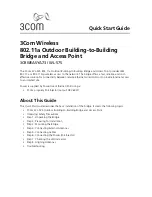
Industry Canada
CAN ICES‑3(A)/NMB‑3(A)
This Class A digital apparatus complies with Canadian CAN ICES‑3(A).
To reduce potential radio interference to other users, the antenna
type and its gain should be so chosen that the equivalent isotropically
radiated power (e.i.r.p.) is not more than that permitted for successful
communication.
This device complies with Industry Canada licence‑exempt RSS standard(s).
Operation is subject to the following two conditions:
1. This device may not cause interference, and
2. This device must accept any interference, including interference that
may cause undesired operation of the device.
This device has been designed to operate with the antennas listed below,
and having a maximum gain of 25 dBi*. Antennas not included in this list
or having a gain greater than 25 dBi are strictly prohibited for use with this
device. The required antenna impedance is 50 ohms.
* Model: NanoStation antenna gain is 25 dBi.
The maximum antenna gain permitted for devices in the bands
5250‑5350 MHz and 5470‑5725 MHz shall comply with the e.i.r.p. limit;
and the maximum antenna gain permitted for devices in the band
5725‑5825 MHz shall comply with the e.i.r.p. limits specified for point‑to‑
point and non point‑to‑point operation as appropriate.
Users should also be advised that high‑power radars are allocated as
primary users (i.e. priority users) of the bands 5250‑5350 MHz and
5650‑5850 MHz and that these radars could cause interference and/or
damage to LE‑LAN devices.
CAN ICES‑3(A)/NMB‑3(A)
Cet appareil numérique de la classe A est conforme à la norme NMB‑3(A)
Canada.
Pour réduire le risque d’interférence aux autres utilisateurs, le type
d’antenne et son gain doivent être choisies de façon que la puissance
isotrope rayonnée équivalente (PIRE) ne dépasse pas ce qui est nécessaire
pour une communication réussie.
Cet appareil est conforme à la norme RSS Industrie Canada exempts de
licence norme(s). Son fonctionnement est soumis aux deux conditions
suivantes:
1. Cet appareil ne peut pas provoquer d’interférences et
2. Cet appareil doit accepter toute interférence, y compris les
interférences qui peuvent causer un mauvais fonctionnement du
dispositif.







































